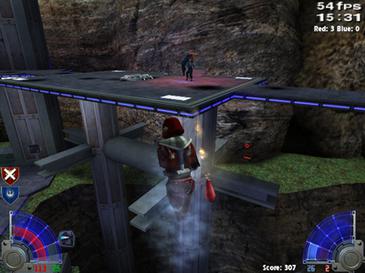LEGO Island 2: The Brickster's Revenge
An adventure of epic proportions spanning multiple islands, interesting and varied characters, and a really cool story. What else did a game need? In my opinion, this game was a true LEGO game. It really matched the feeling of goofing around with LEGO sets, and making weird scenarios to thrust mini-figs into. Oh, and there was the skate park music.
LEGO Island Xtreme Stunts
What do I remember about this game? Epic music. Just epic music. LEGO Island Xtreme Stunts was a fitting end to the series, sporting a bunch of cool mini-games in true LEGO Island fashion. I had a blast exploring the island and getting all of the collectibles.
Hot Wheels Stunt Track Challenge
You know what race I remember from this game? This one. And I had an amazing flashback while playing Koopa Cape Mario Kart Wii. The game had awesome fast paced racing, as well as a bunch of mini-games to spice up the experience. I never actually beat this game, and I got stuck on the first challenge in the final area, but what I did play was a blast.
LEGO Stunt Rally
Lego Stunt Rally wasn't exactly my favorite game, but one thing gave it the privilege of being on this list: the track creator. I have no idea how much of time I spent creating random tracks and racing on them. It was just amazingly fun! I also made countless attempts at going off the borders of the map, but I re-spawned each time.
LEGO Racers 2
LEGO Racers 2 was a pretty awesome game. Although it bears little resemblance to the original other than the concept, it was still fun to play. My favorite part was exploring the several thematically distinct areas that the game had to offer. Multi-player was pretty awesome too.
LEGO Racers
Sonic Adventure DX
LEGO Racers was great! Just amazingly fun! The game had great artistic style, and left a lasting impression on me. What's great is the physics, which stick to what's fun, as opposed to what looks real. Multi-player was a blast to play with friends, and I loved leaving them in the dust with my amazing knowledge of the shortcuts! It's also noteworthy that this game is 11 years old, yet installs and runs without a hitch on my Vista Core i7.
Sonic Adventure DX
Sonic Adventure DX is probably one of the best Sonic games that I have ever played (Shares the spot with Sonic Adventure 2 Battle). Someday, I'd like to play the original Dreamcast games. This game was probably one of the best games that I have ever played, and exemplified everything good about Sonic. It had cool music too! Multiple characters, fast paced game-play, great environments, and an awesome story all came together to create this work of art, which I still enjoy today.













.jpg)













.jpg)